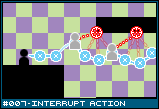|
Mechanic #007 - Interrupt Action |

Category: Tactics | Posted: 05/15/07
If a complex movement can be broken down into nodes, actions can be interrupted at specific points to provide the basis for addition supporting actions. |
In the last entry, it was shown that by using nodes, complex movement actions can be factored in to a turn based game without requiring direct control (like the Worms games do). In this one, I want to show the logical extension of that idea - that complex actions may be interrupted to start a new action.
![[interrupt1.png]](set01/img/entry007-interrupt1.png)
Shown above is a running jump. This is not a movement that would be factored into the regular move action. Instead, it is a special action, selected from a list of potential actions based on the unit's state and surrounding environment. For instance, standing where he is, he would not be able to use a grappling hook to latch onto that upper platform. There could be dozens, if not hundreds, of situation based movement actions.
As you can see, even this action is broken into available nodes. Though it is one continuous action that will need to be seen to completion, it is possible to cause a single interrupt at one of the nodes. Doing so will bring up a new list of context senstive actions perhaps even combat.
![[interrupt2.png]](set01/img/entry007-interrupt2.png)
Here, the action is interrupted at the height of the jump. There are a few actions available to the unit here that wasn't available before. For instance, if there were an enemy standing below him, he could do a back flip and fire down at him from above. In this case, he's now close enough to that platform that he can fire a grappling hook at it.
![[interrupt3.png]](set01/img/entry007-interrupt3.png)
This is the final movement for this action. He leaps up into the air, then halfway through, he fires a grappling hook to the second floor platform, allowing him to climb up on it. Using this system, a very complex movement and combat scheme can be modeled such that the action is as smooth and flowing as a John Woo movie.
![[interrupt4.png]](set01/img/entry007-interrupt4.png)
Interrupted actions could be interrupted themselves. For instance, if the unit had used the grappling hook to target the lower corner instead of the upper one, he would swing in an arc below the second floow. He could then interrupt this swinging and fire the grappling hook again and swing even further.
Perhaps the way to balance this would be to simply give each unit a number of interrupts to use each turn. A unit like a platemail armored knight may not be able to interrupt an action at all, while something like Spider-man can perform excessive acrobatics. Also, making only certain interruptable actions available could make a difference. Spider-man can do a backwards flip into a web swing up to cling on to the underside of an overhang, while the knight may be able to interrupt a jump to do a dive with his sword out.
Using a very simple modification, every unit can move simultaneously each turn. Because of the complex choreography available with this system, if you were to play the entire match back with simultaneous turns, it would present a single, uninterrupted action scene. The modification is simply to apply a visual arc to each unit's movement, and just have it auto-attack any enemy unit within that arc.
![[simult1.png]](set01/img/entry007-simult1.png)
For instance, here is a wallrun move. The black unit runs up the wall, then does a backflip, landing a few squares behind. Using the system above, to fire, let's say, duel pistols in the middle of the backflip, you'd have to interrupt the action at the specified node, then manually highlight and target the enemy unit. However, if we give each node a vision cone...
![[simult2.gif]](set01/img/entry007-simult2.gif)
At each node, there is a certain amount of targetable space that is seen. If an enemy unit is in the cone, it will automatically be targeted and fired upon - all the while the enemy unit is doing its own actions. He might have selected the black unit to fire on, and his arc will follow the black unit up the wall and through the flip, so long as the black unit stays within range and make a smooth movement (if black teleports behind red, red will have lost sight of black and will not turn his vision cone).
In other words, you've got direct targeting, where a unit will attempt to follow a specified target, and indirect targeting, where so long as an enemy (any enemy) is within the "kill zone", it will automatically be attacked.
|